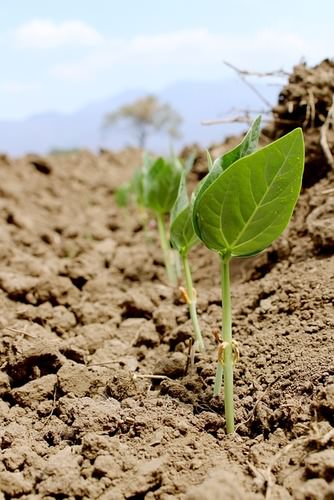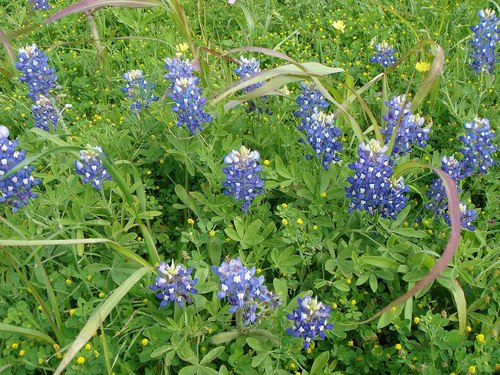13.50 种子多产和加分 -- -- 高级
章节大纲
-
Seed Dormancy and Germination
::种子繁殖和发芽If you decide to plant the seeds of Texas’ state flower , the bluebonnet, to celebrate spring, you will be disappointed. No amount of special soil , exact moisture levels, ideal temperatures, sunlight, or patience will induce the seeds to sprout. In nature, bluebonnet seeds germinate in the fall; as small, inconspicuous plants, they spend the winter developing strong root systems. Moreover, only about 20% of the seeds germinate each season – an advantage for a plant living in regions that have periodic, lethal droughts. The secret to orchestrating this complex pattern of seed germination is dormancy .
::如果你决定播种德克萨斯州花朵的种子 — — 蓝邦特(Bluebonnet ) — —以庆祝春天,你将感到失望。 没有多少特殊的土壤、确切的水分水平、理想温度、阳光或耐心能诱发种子发芽。 在自然界,蓝邦特(Bluebonnet ) 种子在秋天发芽;作为小的、不显眼的植物,它们花在冬季发展强大的根系统。 此外,每季只有大约20%的种子发芽 — — 对于生活在周期性、致命干旱地区的植物来说,这是一个优势。 策划这种复杂的种子发芽模式的秘密是宿舍。Bluebonnet seeds germinate only in the fall, when proper light and moisture conditions. Even under these conditions, 80% remain dormant. The heavy-coated seeds require scarification – soil and rock abrasion, freeze-thaw cycles, or animal chewing – in order to break dormancy. Many plants living in seasonally inhospitable or unreliable environments use dormancy to “time” germination for optimal growing conditions. Seeds dispersed by fruit-eating may use dormancy to prevent untimely germination before consumption and dispersal . Seed dormancy is the failure of a viable seed to germinate under favorable conditions. Seeds may be dormant because the seed coat prevents germination, or because the embryo - by itself or together with chemicals - inhibits germination.
::许多生活在季节性不适宜或不可靠的环境中的植物利用宿舍为最佳生长条件进行“时间”发芽。吃水果所散布的种子可能利用宿舍来防止在消费和散布之前不及时的发芽。种子宿舍是可行的种子在有利条件下无法发芽。种子可能因为种子外套防止发芽而休眠,或者因为胚胎本身或与化学品一起抑制发芽。Seed c oats render seeds dormant if:
::种子涂层使种子休眠,如果:-
their hardness prevents the embryo from expanding
::它们的坚硬阻止胚胎膨胀 -
impermeability to
stops
::停止的不可渗透性 -
impermeability to gases keeps oxygen from reaching the embryo
::气体的渗透性使氧气无法到达胚胎
Embryos may cause seeds to be dormant if they are immature at dispersal and require time to develop or grow to the point of germination. Often, embryo dormancy teams with physiological dormancy, involving chemicals or such as .
::如果种子在散布时不成熟,需要时间开发或生长到发芽点,胚胎胚胎宿舍小组往往具有生理宿舍,涉及化学品或诸如化学品等。Many seeds have more than one type of dormancy – both hard coats and chemicals, for example. Others never show dormancy at all; mangrove seeds, for example, germinate on the tree so that seedlings are well developed before they fall and attempt to begin life on their own. Most seeds, however, interrupt embryo development to some degree – for one or more of three reasons:
::许多种子有不止一种宿舍 — — 比如硬外套和化学物质。 其他人从未表现出过宿舍;例如,红树林种子在树上发芽,这样幼苗在掉落之前就已经发育良好,并试图自己开始生存。 然而,大多数种子在某种程度上干扰胚胎发育 — — 原因有三种或三种以上:-
Dormancy allows dispersal of seeds away from parent plants. Dispersal reduces
among offspring and between offspring and parents.
::富饶使得种子能够从母植物中散布出去,分散在后代之间以及子孙和父母之间减少。 -
Dispersal also increases the chance that a
can colonize new
habitats
.
::分散还增加了能够殖民新生境的可能性。 -
Dormancy allows seedlings to emerge under optimal environmental conditions, avoiding harsh seasonal or unpredictable conditions.
::繁殖让幼苗在最佳环境条件下出现,避免严酷的季节性或不可预测的条件。
At some point, this interruption must be overcome, development of the embryo must resume, and the seed coat must be shed. This process is seed germination.
::在某个时候,必须克服这种中断,必须恢复胚胎的发育,必须脱下种子外套。这是一个种子发芽的过程。Breaking dormancy must precede seed germination. Conditions that induced dormancy (hard seed coat, impermeable seed coat, immature embryo, chemical growth inhibitors) must be eliminated. Many conditions that break dormancy coincide with optimal growing states for seedlings; others signal that an inhospitable season has passed, or dispersal is complete.
::断间宿舍必须先于种子发芽。 必须消除诱发宿舍的条件(硬种子大衣、不渗透种子大衣、不成熟胚胎、化学生长抑制剂 ) 。 许多断间条件与最佳育苗生长状态同时并存;其他条件则表明不适宜季节已经过去,或者分散已经完全完成。Seed coats become softened or more permeable through:
::种子大衣通过下列途径变软或更渗透:-
chewing by animals
::被牲畜咀嚼的, -
freezing and thawing of soil surface water
::土壤地表水的冷冻和提炼 -
battering against streambed rocks
::打击溪流岩石 -
passing through an animal’s
(e.g. a bird’s gizzard)
::穿过动物的行走(例如鸟的雪沙)
Inhibitory chemicals may be removed, inactivated, or no longer produced through:
::可通过下列方式清除、停止或不再生产生化化学品:-
Rainwater or snowmelt may gradually wash chemicals from seeds.
::雨水或雪熔可能逐渐从种子中冲洗化学品。 -
Penetration of precise amounts of light through thin seed coats may be required, preventing germination of seeds buried too deeply or not deeply enough.
::可能需要通过薄种子大衣穿透确切数量的光线,防止埋得太深或不够深的种子发芽。 -
Specific (seasonal) periods of light – or dark – may remove inhibition. Production of abscisic acid, which inhibits germination, is sensitive to amount of light.
::特定(季节性)光(或暗)光(或暗)期可以消除抑制。 生产抑制发芽的腹痛酸对光量十分敏感。 -
By lowering moisture content, drying stimulates germination in some species, such as certain grasses.
::通过降低水分含量,干燥刺激在某些物种,如某些草中发芽。 -
High temperatures induce germination in species such as cocklebur and amaranth.
::高温会诱发象和芳香等物种的发芽。 -
Cool temperatures may be required (vernalization) to remove dormancy in species such as celery.
::可能需要冷却的温度(温度化)来去除诸如大肠胃等物种的宿舍。
Armed with this understanding of seed “behavior”, horticulturalists have developed techniques for germinating seeds that reflect these requirements for breaking dormancy. Seeds with hard coats, for example, require scarification : treatment with acid or microorganisms, soaking in hot water, or even poking with pins. Some seeds with inhibitory chemicals receive stratification treatments: periods of additional moisture and chilling simulate outdoor weather conditions. Leaching – soaking in cold or hot water – removes inhibitory chemicals in other species. Drying, , variable temperatures, and light cycle alteration are additional artificial treatments which simulate seed dormancy-breaking conditions in nature.
::园艺学家根据对种子“行为”的这种理解,开发了种子繁殖技术,这些技术反映了断绝宿舍的这些要求。 比如,带有硬外套的种子需要留下疤痕:用酸或微生物治疗,在热水中浸泡,甚至用针刺。 一些含有抑制性化学品的种子得到分层处理:额外的湿度和冷却模拟户外气候条件的时期。 渗漏 — — 浸泡在冷水或热水中 — — 清除了其他物种的抑制性化学物质。 干燥、变化的温度和光循环改变是其他模拟种子破坏性条件的人工治疗。Now you can perhaps understand why bluebonnet seeds won’t help you celebrate spring: they require scarification (either natural or artificial) and burial to a certain depth, allowing just the right amount of light from 8-10 hours’ sun. In nature, these conditions take time – so just 20% of seeds break dormancy and germinate in one season (fall). The remaining 80% germinate in subsequent years as dormancy-breaking conditions are met, providing “insurance” against a season or two of drought. Only if you artificially scarify seeds, and plant them at the proper in late summer or fall, can you induce most of the seeds to germinate for your yard or garden in a single season, to bloom the following year.
::现在,你也许可以理解为什么蓝邦种子无法帮助你庆祝春天:它们需要留下疤痕(自然或人工)并埋到一定的深度,让8-10小时的太阳光光量保持正确的水平。 在自然中,这些条件需要时间 — — 因此只有20 % 的种子在某一季节( 落地 ) 断绝宿舍和发芽。 其余80%的种子在随后几年中发芽,因为宿舍破碎条件已经满足,它们为一季或两季干旱提供了“保险 ” 。 只有当你人工刮伤种子并在夏末或秋天将种子埋在正常位置时,你才能将大部分种子在一季的院子或园子发芽,在下一年开花。How Do Seeds Germinate?
::种子怎么发芽?If a seed is viable (embryo still living), dormancy conditions have been overcome, and environmental requirements (water, oxygen, temperature, light) are adequate, the seed will germinate. Germination involves three stages:
::如果种子有生存能力(胚胎还活着),居住条件已经克服,环境要求(水、氧气、温度、光)已经足够,种子将发芽。-
Water is absorbed through the seed coat, the seed swells, and the seed coat splits open.
::水通过种子大衣吸收,种子膨胀,种子大衣裂开。 -
Metabolism
resumes. Water activates
hydrolytic enzymes
, which break down the seed’s
food
supply into molecules the embryo uses for growth. Oxygen is essential for
aerobic respiration
during this phase; seeds too deeply buried or lodged in waterlogged soil may die. Gibberellin hormones stimulate
.
::新陈代谢复发。 水能激活水解酶,将种子的粮食供应分解为分子,胚胎用于生长。 在这一阶段,氧对有氧呼吸至关重要;深埋的种子或埋在水土中的种子可能会死亡。 吉贝利林激素刺激了这一阶段。 -
The embryo emerges. The embryonic root or
radicle
emerges first from the seed. Positively geotropic (
geotropism
), the radicle grows down into the soil, taking in water and anchoring the seedling. After absorbing water, the shoot, consisting of primordial
and
cotyledons
(seed leaves), emerges. Negatively geotropic, the shoot grows upward. In some species, the stem elongates and pulls the cotyledons above the ground to photosynthesize for the seedling; in others, seed leaves remain underground and the shoot forms the first leaves.
::胚胎出现。 胚胎根或弧形首先从种子中显现出来。 积极的地球热带( 地球生物学 ) , 辐射细胞在土壤中生长, 吸收水并固定幼苗。 在吸收了水后, 由原始和隐形树叶( 种子叶) 组成的射击就出现了。 消极的地球学, 射击会向上发展。 在有些物种中, 干叶长, 将地上带宽, 将树叶拉到树苗的光合体上; 在另一些物种中, 种子叶仍然留在地下, 射击形成第一个叶子。
A seedling with photosynthetic leaves is soon independent of the seed’s food supply (indeed, it has probably exhausted this food supply to develop to the point of independence). The begins anew.
::与光合作用叶子的育苗很快独立于种子的粮食供应(事实上,它可能已经耗尽了这种食物供应以发展到独立的地步 ) 。 重新开始。Summary
::摘要-
Seed dormancy is the failure of a viable seed to germinate under otherwise favorable conditions.
::种子宿舍是指一个可行的种子在本来有利的条件下无法发芽。 -
Dormancy allows seed dispersal, reducing intraspecies competition and increasing colonization.
::繁殖权允许种子散布,减少物种内部竞争,并增加殖民化。 -
Dormancy helps seedlings to avoid harsh seasonal or unpredictable environmental conditions.
::多栖动物帮助幼苗避免严酷的季节性或不可预测的环境条件。 -
Hard, impermeable seedcoats, underdeveloped embryos, and inhibitory chemicals create dormant seeds.
::硬性、不渗透的种子外套、发育不良的胚胎和抑制性化学品产生休眠种子。 -
Scarification breaks dormancy in the same way that freeze/thaw cycles and animal chewing or digestion do.
::疤痕打破了宿舍,就像冷冻/破碎循环和动物咀嚼或消化一样。 -
Rainwater, drying, temperature, or light changes may break chemical dormancy in nature and horticulture.
::雨水、干燥、温度或灯光变化可能会破坏自然和园艺中的化学容留性。 -
Seeds germinate by absorbing water, resuming metabolism, and finally liberating the embryo.
::种子通过吸收水、恢复新陈代谢和最终解放胚胎而发芽。
-
their hardness prevents the embryo from expanding

